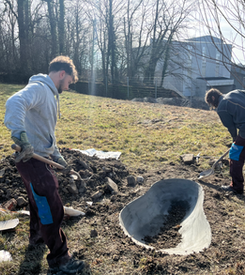Unkenwannen as a continuation of extensive care and upgrading measures
Realized:
2024
carried out by:
Naturnetz Mittelland
Realized:
Zug, Schweiz
To ensure that nature reserves remain as habitats, the
Nature network in spring 2024 in the canton of Zug various enhancement
measures – with a particular focus on the yellow-bellied toad.
The nature reserves in the canton of Zug are spread throughout the canton and play a crucial role as habitats and connectivity areas in the intensively used cultural landscape. Many of these protected areas were deliberately created by humans to provide a suitable habitat for endangered, often highly specialized species. To ensure they can fulfill this function in the long term, they are regularly maintained by the Nature Network.
Creating living space
The goal is to preserve the ecological value of the nature reserves in the canton of Zug over the long term. This requires regular maintenance interventions to counteract bush encroachment by fast-growing trees and the silting up of ponds. In addition, the habitat of target species, such as the yellow-bellied toad, is being specifically promoted. To this end, existing spawning waters (toad ponds) are being maintained or expanded. This problem is being solved through targeted maintenance and improvement measures, particularly through the pruning of trees and work in and around water. These interventions are preferably carried out in winter, as this is the optimal time to minimize the impact on nature.
These measures are essential for preserving biodiversity, as without regular maintenance, important habitats for numerous animal and plant species would be lost. Valuable open spaces would become overgrown and wetlands would increasingly silt up, which could significantly reduce biodiversity.
Even more toad tubs
In the Tännlimoosweid and Oberwilerwald areas, the focus was on promoting the yellow-bellied toad by creating toad pits. In the Tännlimoosweid area, this first involved removing dense dogwood and blackberry bushes to create sufficient space. At the same time, the resulting light conditions improved the living conditions of the toads. In the Oberwilerwald area, the existing toad habitat was to be expanded with additional pits. The installation of the lightweight Eternit pits is carried out entirely by hand. The soil conditions play a crucial role in optimal installation. In teams of two, a precisely fitting hole in the shape of the toad pit is first dug using a shovel, spade, and pickaxe.
It is crucial that the tray is leveled so that it can fill evenly with rainwater.












